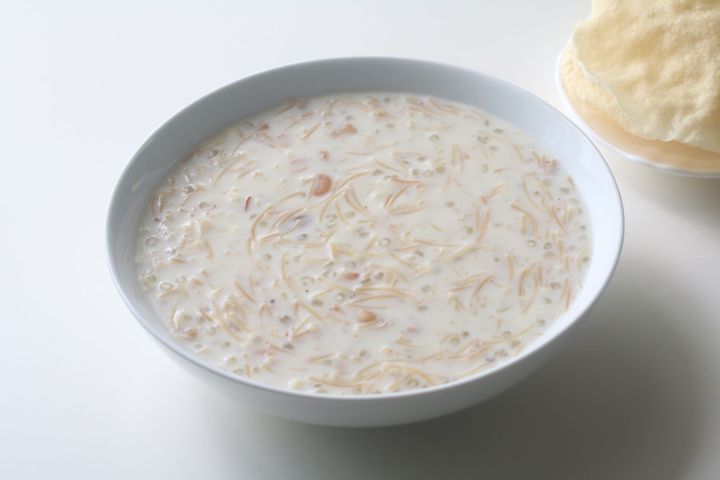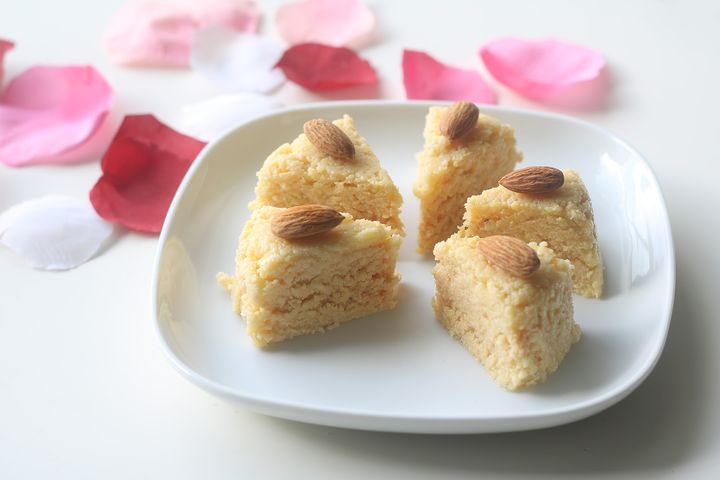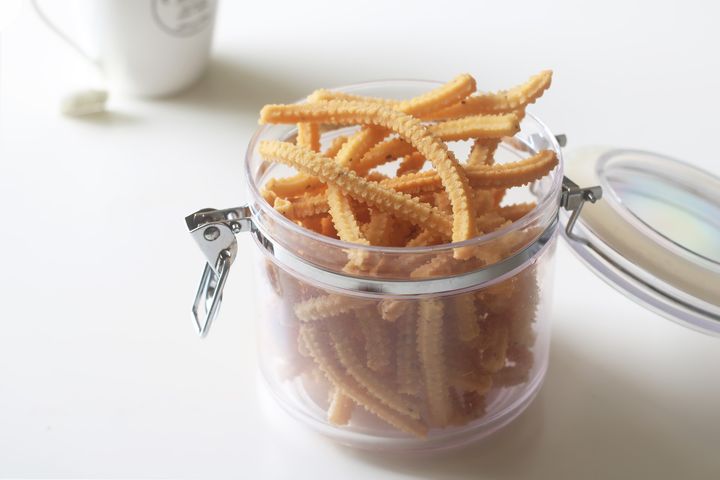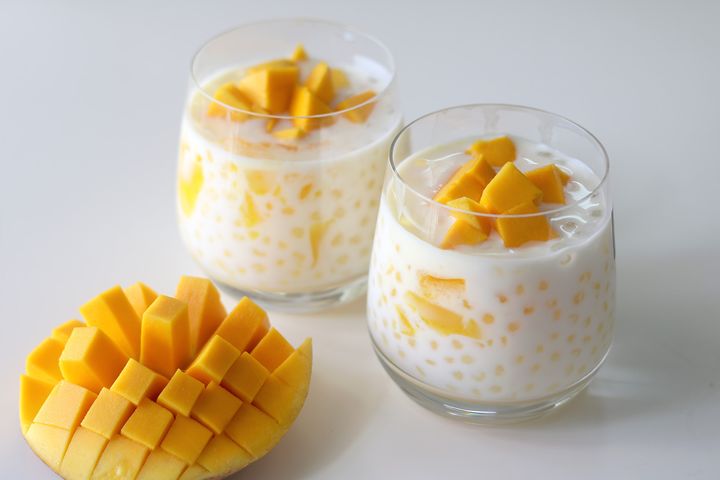Ashoka Halwa /Pasi Paruppu Halwa
Are you a fan of traditional South Indian sweets? Then you have to try Ashoka Halwa / Pasi Paruppu Halwa!
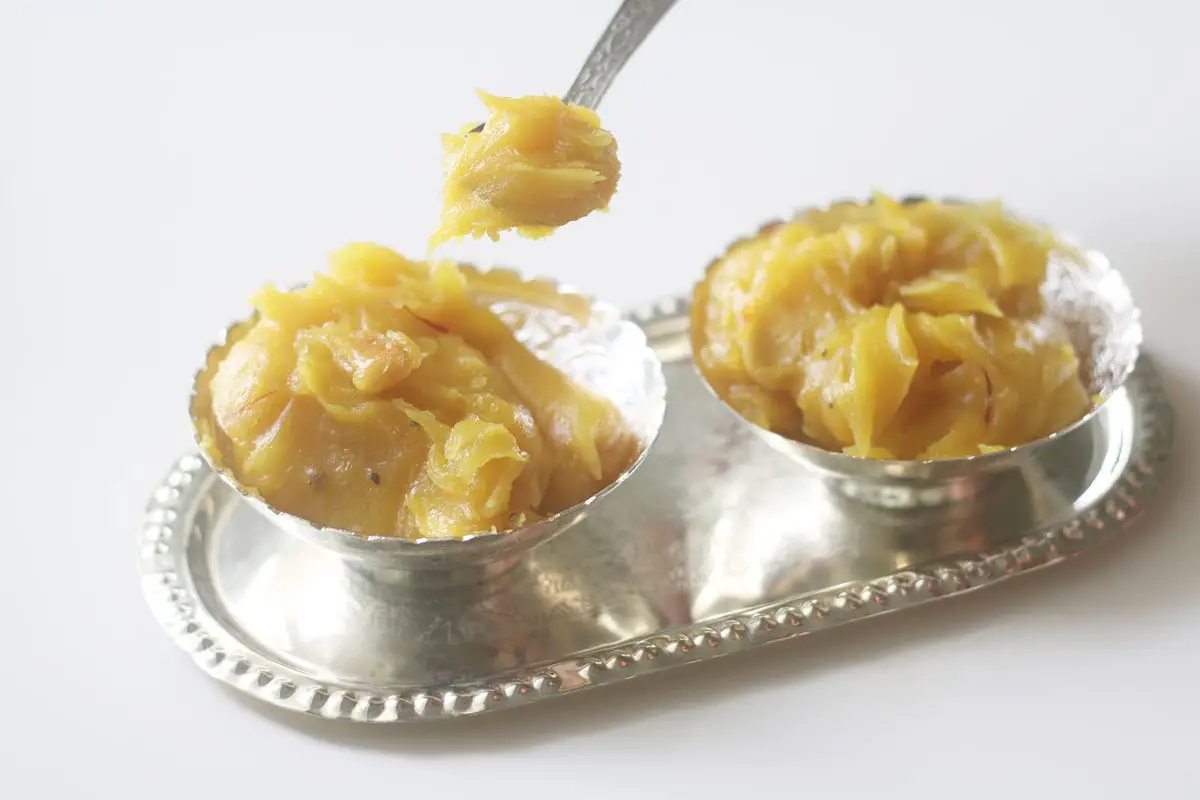
Ashoka Halwa recipe with step-by-step photos. Are you a fan of traditional South Indian sweets? Then you have to try Pasi Paruppu Halwa! Hailing from the beautiful Thiruvaiyaru in the Tanjore district of Tamil Nadu, this sweet treat is a staple in marriage and celebration tables throughout the area.
With its velvety, melt-in-your-mouth texture, it's no wonder why Ashoka Halwa is so highly sought after. But the best part? It's made with just a few simple ingredients and is a breeze to prepare.
So, why not gather your friends and give this timeless dessert a try? We can't wait to hear your thoughts and opinions!
What Is Ashoka Halwa?
- Ashoka halwa is a delectable Indian dessert made with Moong dal, sugar, ghee, and a blend of aromatic Indian spices. This indulgent sweet treat combines the succulent moong dal with the rich flavors of ghee, cardamom powder, and saffron, creating a unique and flavorful dessert that is loved by many.
- The combination of these main ingredients, along with the addition of wheat flour, cashews, and hot water, results in a mouthwatering halwa that is perfect for satisfying your sweet cravings. With its smooth and glossy texture, ashoka halwa is a delightful and traditional Indian dessert that is sure to tantalize your taste buds.
Why You'll Love Ashoka Halwa?
- Deliciously Smooth Texture: The Ashoka Halwa has a wonderfully smooth and creamy texture that simply melts in your mouth. The moong dal paste gives it a rich and luxurious consistency, making it a truly indulgent dessert.
- Health Benefits of Moong Dal: Moong dal is packed with protein and fiber, making this sweet treat a guilt-free indulgence. It is also low in fat and cholesterol, making it a healthier option for satisfying your sweet cravings.
- Saffron for a Luxurious Touch: The addition of saffron not only gives the halwa a beautiful golden color but also adds a luxurious aroma and flavor to the dish. It's the perfect touch to elevate this traditional Indian dessert.
- Rich in Nutrients: With the goodness of moong dal, ghee, and cardamom, Ashoka Halwa is not only delicious but also rich in essential nutrients. From protein to healthy fats and antioxidants, this dessert is a wholesome treat for your taste buds and your body.
- Garnished with Cashews: The crunchy, nutty flavor of cashews adds a delightful contrast to the creamy texture of the halwa. It not only enhances the taste but also provides a satisfying crunch in every bite.
- Traditional Indian Dessert with a Modern Twist: Ashoka Halwa is a classic, time-honored Indian dessert that has been given a modern twist with the addition of saffron and a hint of cardamom. It's a perfect blend of tradition and innovation, making it a must-try for anyone with a sweet tooth.
Ingredients for Ashoka Halwa
- Moong dal: Moong dal is the main ingredient in this recipe and is responsible for giving the halwa its smooth and creamy texture. It also adds a nutty flavor to the dish.
- Ghee: Ghee is used for roasting the moong dal and adds a rich, buttery flavor to the halwa.
- Sugar: Sugar sweetens the halwa and is essential for achieving the perfect balance of flavors.
- Wheat flour: Wheat flour is added to the halwa to thicken the mixture and provide a nice, subtle nutty flavor.
- Cardamom powder: Cardamom powder adds a warm and aromatic flavor to the halwa, enhancing its overall taste.
- Saffron: Saffron not only adds a beautiful yellow color to the halwa but also imparts a subtle, floral flavor to the dish.
How To Make Ashoka Halwa?
If you want to make a delicious and flavorful Ashoka Halwa, follow these simple steps. It's important to follow each step carefully to ensure the best possible outcome for your dish.
- Start by dry roasting the moong dal until a nice aroma comes. Then, wash it 2-3 times and pressure cook it until it's soft and mushy.
- While the dal is cooking, prepare a saffron mixture and roast the cashews in ghee.
- Next, roast the wheat flour in ghee until aromatic, then add the cooked dal mixture and cook until slightly thick.
- Add sugar and cook for at least 10 minutes, then add the saffron mixture and continue cooking until it becomes thick.
- Add ghee at regular intervals and mix until the mixture turns glossy, then add cardamom powder and fried cashews.
- Keep cooking on low heat until the mixture separates from the pan, then remove from heat and serve.
By following these steps, you'll be able to create a delicious and flavorful Ashoka Halwa that everyone will love!
Serving Suggestions
- Pair with savory snacks: Ashoka halwa can be served with savory snacks like samosas or pakoras to balance out the sweetness of the dessert.
- Accompany with a warm beverage: Enjoy a cup of masala chai or filter coffee alongside a serving of ashoka halwa for a delightful Indian dessert experience.
- Serve with creamy ice cream: A scoop of vanilla or cardamom-flavored ice cream pairs beautifully with the rich and decadent ashoka halwa, creating a delightful contrast of temperatures and flavors.
- Garnish with nuts and dried fruits: Sprinkle chopped pistachios, almonds, or dried rose petals on top of the halwa for added texture and visual appeal.
- Enjoy with traditional Indian breads: Serve ashoka halwa with a side of warm roti, paratha, or naan for a complete and satisfying meal.
- Pair with rice dishes: Create a fusion dessert experience by serving ashoka halwa with fragrant saffron rice or creamy rice kheer. The combination of textures and flavors will surely impress your guests.

Tips for Making Ashoka Halwa
- Preparation Duration: Preparation for Ashoka Halwa may take around 10 minutes for roasting the moong dal and another 20 minutes for pressure cooking. Additionally, the cooking process may take around 30 minutes to achieve the desired consistency and texture of the halwa.
- Cooking Techniques: To ensure the perfect texture and taste of the Ashoka Halwa, it is essential to roast the moong dal until a nice aroma comes. Additionally, mashing the dal well or grinding it until smooth is crucial for the halwa to have the right consistency.
- Importance of Garnishing: A final touch of garnishing with fried cashews and a sprinkle of cardamom powder not only adds to the visual appeal of the Ashoka Halwa but also enhances its flavor. The presentation of the halwa is as important as its taste, so do not skip the garnishing step.
- Balancing the Ingredients: Ensure to balance the sweetness and richness of the halwa by adjusting the quantity of sugar, ghee, and saffron to suit your taste preferences. It's important to continuously stir the halwa during the cooking process to prevent it from sticking to the pan and to achieve a smooth, glossy texture.
- Consistency Check: During the cooking process, pay close attention to the consistency of the halwa. It should be thick and glossy, and it should eventually separate from the pan. Be patient as achieving the right consistency is key to a perfect Ashoka Halwa.
- Serving Suggestions: For a delightful presentation, consider serving the Ashoka Halwa in decorative serving bowls or on colorful dessert plates. You can also garnish it with a few strands of saffron and additional chopped nuts for an appealing final touch.
By following these tips, you can create a delicious and visually appealing Ashoka Halwa that will surely impress your family and friends.
Variations for Ashoka Halwa
- Nutty Twist: Instead of cashews, try using almonds, pistachios, or walnuts for a different flavor and texture.
- Fruity Flavour: Add in some chopped dried fruits like raisins, apricots, or dates to add a hint of sweetness and chewiness to the halwa.
- Coconut Crunch: For a tropical twist, sprinkle some grated coconut on top of the halwa before serving to complement the creamy texture.
- Spice it Up: Experiment with adding a pinch of cinnamon or nutmeg for a warm, spicy undertone to the halwa.
- Healthy Sweetener: Replace sugar with jaggery or honey for a healthier alternative and a unique, earthy sweetness.
- Flavor Infusion: Infuse the ghee with a flavoring agent like rose water or kewra water for a fragrant and aromatic twist to the ashoka halwa.
How to Store Ashoka Halwa
- Storing the Ashoka Halwa: After preparing the delicious Ashoka Halwa, it's important to store it properly to maintain its freshness and flavor. Store the halwa in an airtight container to prevent it from drying out or absorbing any unwanted odors from the surroundings.
- Refrigeration: You can store the Ashoka Halwa in the refrigerator for up to 1 week. Make sure to cool it down to room temperature before storing it in the fridge.
- Freezing: If you have a large batch of Ashoka Halwa, you can also freeze it for longer storage. Place the halwa in a freezer-safe container or ziplock bag, label it with the date, and store it in the freezer for up to 2 months.
- Thawing: When you're ready to enjoy the frozen Ashoka Halwa, simply thaw it in the refrigerator overnight. You can reheat it in the microwave or on the stovetop for a warm and delicious treat.
- Key Ingredient Storage: To maintain the freshness of key ingredients like moong dal and ghee, store them in a cool, dry place away from direct sunlight. Keep them in airtight containers to prevent spoilage and maintain their quality for future use.
- Saffron and Cardamom: Store saffron and cardamom in airtight containers in a cool, dark place to preserve their flavor and aroma. These spices are essential for adding the perfect touch to your Ashoka Halwa.
- Cashews: Keep the chopped cashews in an airtight container in the refrigerator to prevent them from turning rancid. They will stay fresh and crunchy for a longer period.
By following these simple storage tricks, you can ensure that your Ashoka Halwa stays fresh and delicious for as long as possible. Enjoy the sweet and aromatic flavors of this classic Indian dessert whenever the craving strikes!
Frequently Asked Questions (FAQs)
How can I adjust the sweetness level of the ashoka halwa?
- You can adjust the sweetness level by adding more or less sugar according to your preference. Start with the recommended amount and then taste the halwa. You can always add more sugar if you prefer it sweeter, or reduce the amount if you prefer it less sweet.
Can I make the ashoka halwa without ghee?
- While ghee adds a rich and traditional flavor to the halwa, you can make it with a smaller amount of ghee or substitute it with another type of oil. Keep in mind that the flavor will be slightly different, but it is still possible to make the halwa without ghee.
How do I know when the halwa is ready to be removed from the heat?
- The halwa is ready when it starts to separate from the pan and has a glossy appearance. You can also check the consistency by running a spoon through the halwa, and if it holds its shape, it's ready to be removed from the heat.
Can I make the ashoka halwa in advance?
- Yes, you can make the ashoka halwa in advance and store it in an airtight container in the refrigerator. When you're ready to serve it, gently reheat it on the stovetop, adding a little ghee if necessary to restore its creamy texture.
What can I serve with the ashoka halwa?
- The ashoka halwa can be served on its own as a dessert or alongside a savory meal. You can also garnish it with chopped nuts, such as cashews or almonds, for added texture and flavor.
Can I use a different type of dal to make the ashoka halwa?
- The traditional ashoka halwa is made with moong dal, but you can experiment with other dals, such as chana dal or urad dal, to create unique variations of the halwa. Keep in mind that the cooking time and texture may vary when using different types of dals.
Recipe Card
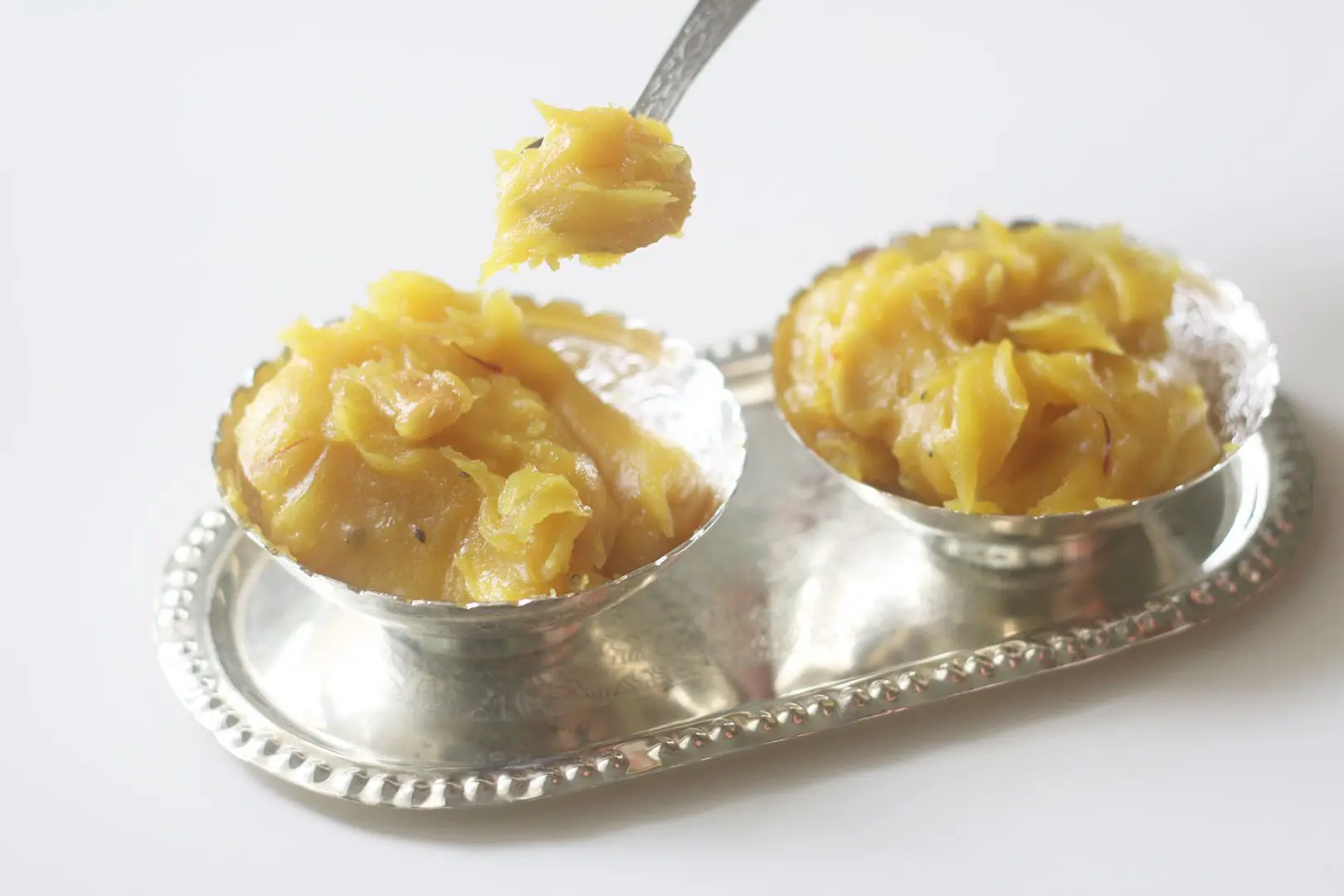
Ashoka Halwa / Pasi Paruppu Halwa
Serving Size: 4
Prep Time: 10 minutes
Cook Time: 30 minutes
Total Time: 40 minutes
Ingredients
For Cooking Moong Dal
- ½ cup Moong dal / pasi paruppu
- 2 cups water
- 1 tsp ghee
- A pinch of salt
For Moong Dal Halwa
- 1 cup Sugar
- 1 tablespoon Wheat flour
- 1/4 cup ghee + 2 tbsp ghee
- ¼ teaspoon Cardamom powder
- A dash of saffron
- 1 tbsp hot water
- 8 cashew nuts, chopped
Instructions
- Dry roast moong dal for 2 to 3 minutes or until a nice aroma comes.
- Remove from the heat and wash 2 to 3 times.
- Place the moong dal in a pressure cooker and then add 1 tsp of ghee and 2 cups of water. Cover and pressure cook for 3 whistles or until mushy and soft.
- Mash it well or grind until you get a smooth paste. Add a pinch of salt (optional).
- Meanwhile, in a small bowl, add a dash of saffron and 1 tbsp of hot water, mix well and keep it aside.
- In a kadai, heat 3tbsp of ghee and roast cashews until golden brown over low heat. Remove them from the pan and keep it aside.
- In the remaining ghee, add wheat flour and give a good stir until the flour turns aromatic and its color is lightly changed.
- Then add the ground dal mixture and cook until it becomes slightly thick.
- Then add sugar, stir constantly and cook for at least 10 minutes.
- Further, add saffron mixture and give a good stir. Mix well until the mixture becomes thick.
- Add 1 tbsp of ghee at regular intervals and mix until the mixture turns glossy.
- Finally, add cardamom powder and fried cashews and a tsp of ghee. Keep cooking on low heat until the mixture separates from the pan.
- Remove from the heat and serve!
By Santhi Therese
The Indian Claypot
https://theindianclaypot.com/
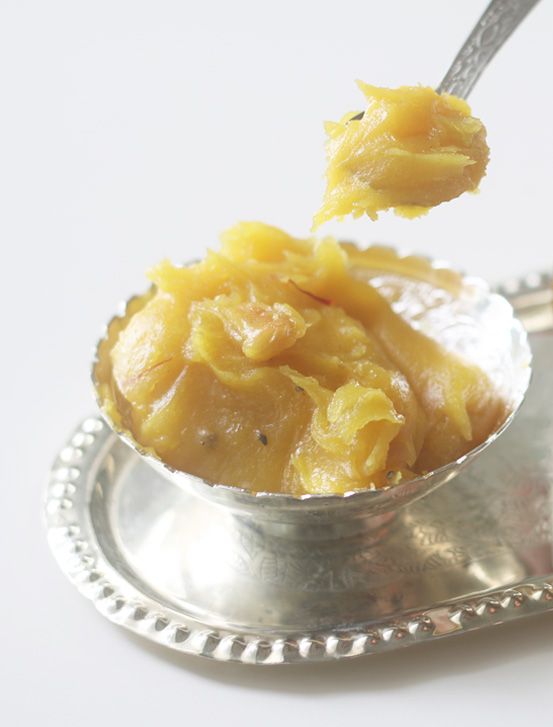
Step-By-Step Instructions:
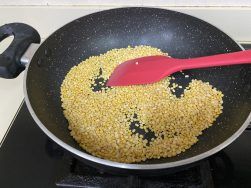
Dry roast moong dal for 2 to 3 minutes over low heat or until a nice aroma comes.
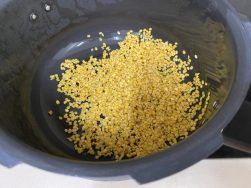
Remove from the heat and wash 2 to 3 times.
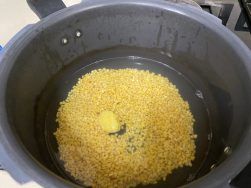
Place the moong dal in a pressure cooker and then add 1 tsp of ghee and 2 cups of water.
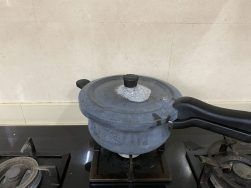
Cover and pressure cook for 3 whistles or until mushy and soft.
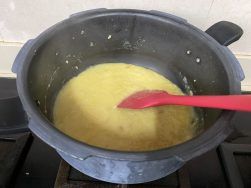
Mash it well
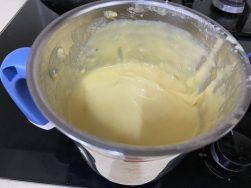
or grind until you get a smooth paste.
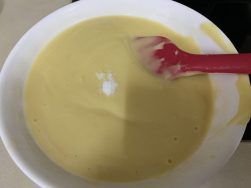
Add a pinch of salt. mix well.
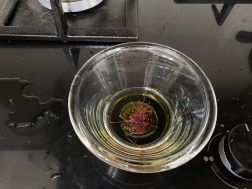
Meanwhile, in a small bowl, add a dash of saffron and 1 tbsp of hot water,
mix well and keep it aside.
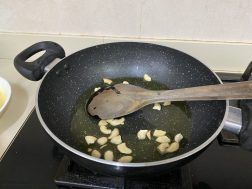
In a kadai, heat 3tbsp of ghee and roast cashews until golden brown
over low heat. Remove them from the pan and keep them aside.
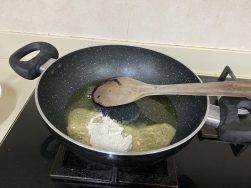
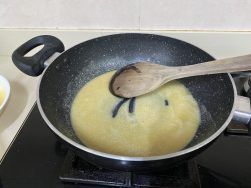
In the remaining ghee, add wheat flour and give a good stir until the flour turns aromatic and it’s color lightly changed as shown in the picture.
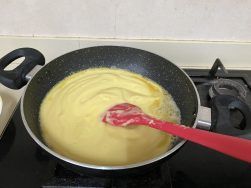
Then add the ground dal mixture and cook until it becomes slightly thick.
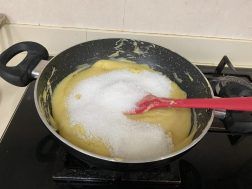
Then add sugar, stir constantly and cook for at least 10 minutes.
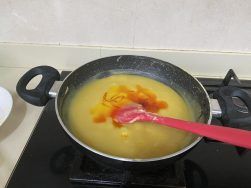
Further, add saffron mixture and give a good stir.
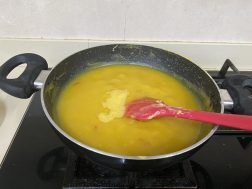
Add 1 tbsp of ghee at regular intervals and mix until the mixture turns glossy.
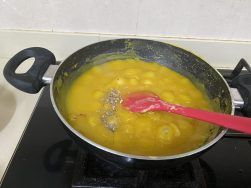
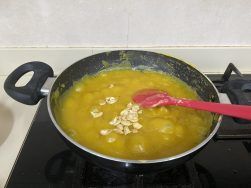
Finally, add cardamom powder and fried cashews and a tsp of ghee.
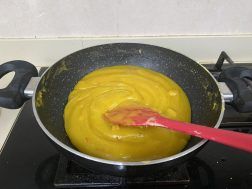
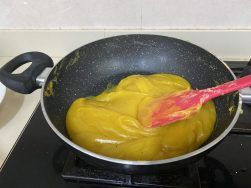
keep cooking on low heat until the mixture separates the pan.
You may also like my other Diwali Sweets posts and recipes like Semiya Payasam Recipe, Milk Cake Recipe, Fried Gram Murukku Recipe, Mango Sago Dessert, Restaurant Style Rava Kesari Recipe, Badusha Recipe, Kasi Halwa Recipe / White Pumpkin Halwa Recipe, Sweet Shakarpara Recipe / Kalakala / Diamond Biscuit, Moong Dal Murukku, Traditional Mysore Pak Recipe, Baked Murukku /Chakli, Green Gram Payasam/Kheer, Kozhukattai Recipe, Kara Boondi Recipe, Moong Dal Susiyam, South Indian Mixture Recipe, Kara Sev Recipe, Sweet Boondi, Milk Halwa, Rava Ladoo Recipe .
